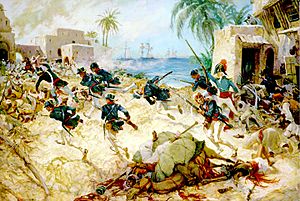First Barbary War facts for kids
Quick facts for kids First Barbary War |
|||||||
|---|---|---|---|---|---|---|---|
| Part of the Barbary Wars | |||||||
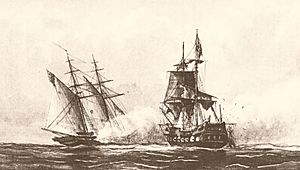 USS Enterprise fighting the Tripolitan polacca Tripoli by William Bainbridge Hoff, 1878 |
|||||||
|
|||||||
| Belligerents | |||||||
| Commanders and leaders | |||||||
|
|||||||
| Strength | |||||||
| United States First Squadron: 4 frigates 1 schooner Second Squadron: 6 frigates 1 schooner Third Squadron: 2 frigates 3 brigs 2 schooners 1 ketch Swedish Royal Navy: 3 frigates William Eaton's invasion: 8 US Marines, William Eaton, 3 midshipmen, and several civilians Approx. 500 Greek and Arab mercenaries |
Various cruisers 11–20 gunboats 4,000 soldiers |
||||||
| Casualties and losses | |||||||
| United States: Philadelphia 35 killed 64 wounded Greek & Arab mercenaries: unknown |
Tripolitania: unknown Morocco: None |
||||||
The First Barbary War (1801–1805) was a fight between the United States and Sweden against Tripolitania. It's also known as the Tripolitan War. This conflict was part of the larger Barbary Wars.
Tripolitania had declared war because of disagreements over payments. These payments were like a "protection fee" to stop Tripolitan ships from attacking merchant ships at sea. The U.S. President, Thomas Jefferson, refused to pay this fee. Sweden had already been fighting Tripolitania since 1800.
Contents
Why Did the First Barbary War Happen?
Pirates and Payments: The Start of the Problem
For a long time, pirates from North African regions like Algiers, Tunis, Tripoli, and Morocco caused trouble in the Mediterranean Sea. These groups were known as the Barbary Coast states. They would capture merchant ships and hold their crews for ransom or sell them. This was how their rulers gained wealth and power.
Before the United States became fully independent in 1783, its ships were protected by France. But after the American Revolution, this protection ended. Soon, American merchant ships started getting attacked. The pirates wanted money from the U.S. government to stop these attacks, just as they did with European countries.
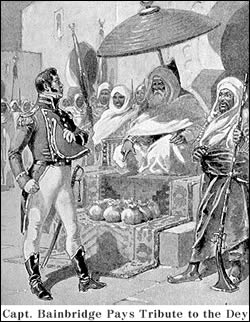
In 1784, Moroccan pirates captured the ship Betsey. Spain helped free the ship and crew. But Spain also told the U.S. to pay the pirates to prevent future attacks. Thomas Jefferson, who was the U.S. Minister to France, sent people to Morocco and Algeria. He hoped to buy peace treaties and free captured American sailors.
Morocco was the first Barbary Coast state to sign a treaty with the U.S. on June 23, 1786. This treaty stopped all Moroccan piracy against American ships. It even said that if Americans captured by other pirates landed in a Moroccan city, they would be set free.
Trouble with Algeria and Tripoli
Dealing with Algeria was much harder. Algerian pirates captured two American ships, Maria and Dauphin, in July 1785. All four Barbary Coast states demanded $660,000 each. However, the U.S. envoys only had $40,000 to offer. Because of this, talks for peace or ransom didn't go well. The crews of Maria and Dauphin stayed captive for over ten years. More American sailors were captured later.
In 1786, Thomas Jefferson and John Adams met with Tripoli's ambassador in London. They asked why Tripoli attacked nations that had done them no harm. The ambassador said their holy book taught that it was right to attack and enslave non-believers. He also said that any Muslim killed in this fight would go to paradise. He described how their sailors would board enemy ships with daggers, scaring their foes into surrender.
Jefferson told John Jay, the Secretary of Foreign Affairs, about this. Jefferson believed that paying tribute would only encourage more attacks. John Adams agreed but felt the U.S. had to pay until it could build a strong navy. The U.S. was deep in debt after its own war.
Life as a Captive and Calls for Action
Captured American sailors described their time as a form of slavery. While some captives could gain wealth, most were forced into hard labor. They lived in terrible conditions, suffering from disease. As news of their harsh treatment reached the U.S., Americans demanded that their government act to stop the piracy.
In 1794, Congress set aside $800,000 to free American prisoners and make peace with Algiers, Tunis, and Tripoli. In 1795, a treaty with Algiers was signed. It included a payment of $642,500 in silver for peace and the release of American captives. The U.S. also agreed to pay a yearly tribute of $21,600 in shipbuilding supplies. This treaty freed 115 American sailors.
Jefferson kept arguing against paying tribute. George Washington and others started to agree with him. The U.S. Navy was rebuilt in 1794, making it possible for America to refuse payments. But the habit of paying tribute was hard to break. The constant demands led to the creation of the United States Department of the Navy in 1798. Its goal was to stop attacks and end the huge tribute demands.
In the 1800 election, Thomas Jefferson became president. He believed that military force, not endless payments, was the way to solve the problem with Tripoli.
War Begins: A Bold Refusal
Tripoli Declares War
Just before Jefferson became president in 1801, Congress passed a law about the navy. It allowed the president to use ships to "protect our commerce and punish their rudeness." If the Barbary powers declared war, these ships could "sink, burn, or destroy their vessels."
In 1801, Yusuf Karamanli, the ruler (Pasha) of Tripoli, demanded $225,000 from the new U.S. government. This was a common demand when a new government took power. But Jefferson refused. Because of this, and because the U.S. had not paid money or gifts from a 1796 treaty, the Pasha declared war on the U.S. on May 10, 1801. He did this in the traditional Barbary way: by cutting down the flagpole in front of the U.S. Consulate. Algiers and Tunis did not join Tripoli in this war.
Before Jefferson knew about Tripoli's declaration of war, he sent a small group of ships. This group, led by Commodore Richard Dale, carried gifts and letters to try and keep the peace. However, if war had been declared, Dale was told to "protect American ships and citizens." But Jefferson also said he couldn't go beyond defense without Congress's approval.
Congress never officially declared war. But it did allow the President to tell American ship commanders to seize Tripoli's ships and goods. The American ships joined a Swedish fleet that was already blocking Tripoli. Sweden had been at war with Tripoli since 1800.
On May 31, 1801, Commodore Edward Preble went to Messina, Sicily. The King of Naples, Ferdinand IV, was at war with Napoleon. But he helped the Americans with sailors, craftsmen, supplies, and gunboats. He also let them use his ports as naval bases. Tripoli was a strong city with walls, 150 heavy cannons, and 25,000 soldiers. It also had a fleet of ships.
On August 1, 1801, the American schooner Enterprise, led by Lieutenant Andrew Sterret, easily defeated the 14-gun Tripolitan ship Tripoli.
In 1802, Congress passed a law allowing the President to use U.S. armed ships to protect American trade and sailors in the Atlantic and Mediterranean. This law also allowed American ships to seize vessels belonging to Tripoli. Any captured property would be given to those who brought the ships into port.
The U.S. Navy was strong at sea, but the war was not over. Jefferson sent more of the navy's best ships to the region in 1802. Many famous ships, like USS Constitution, served in the war under Commodore Preble. Throughout 1803, Preble kept a blockade around the Barbary ports. He also led raids and attacks against the cities' fleets.
Key Battles and Brave Actions
The Capture of USS Philadelphia
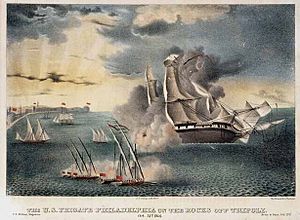
In October 1803, Tripoli's fleet captured the USS Philadelphia. The American frigate got stuck on a reef while patrolling Tripoli harbor. American efforts to free the ship failed, as it was under fire from shore cannons. The ship, its captain William Bainbridge, and all the crew were taken captive. The Philadelphia was then used by Tripoli as a gun battery in the harbor.
Decatur's Daring Raid
On the night of February 16, 1804, Captain Stephen Decatur led a small group of U.S. Marines. They used a captured Tripolitan ship, renamed USS Intrepid. They tricked the guards on the Philadelphia and got close enough to board it. Decatur's men stormed the ship and quickly defeated the Tripolitan sailors. With help from other American warships, the Marines set the Philadelphia on fire. This stopped the enemy from using the ship.
Preble attacked Tripoli again on July 14, 1804. There were several battles, but no clear winner. One attack involved using the Intrepid, packed with explosives, as a fire ship. The plan was for it to enter Tripoli harbor and destroy the enemy fleet. However, the Intrepid was destroyed, possibly by enemy fire, before it reached its target. Captain Richard Somers and his entire crew were killed.
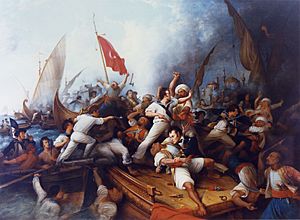
The Battle of Derna: A Turning Point
The most important battle of the war was the Battle of Derna (April–May 1805). William Eaton, a former Army captain, and U.S. Marine Corps Lieutenant Presley O'Bannon led a force. This force included eight U.S. Marines and about 500 mercenaries (fighters for hire) from Greece and Arab lands. They marched across the desert from Egypt to capture the Tripolitan city of Derna.
This was the first time the United States flag was raised in victory on foreign soil. This event is remembered in the Marines' Hymn with the line "to the shores of Tripoli." Capturing Derna gave American negotiators a strong position. It helped them get the hostages back and end the war.
Peace and What We Learned
Signing the Peace Treaty
Yusuf Karamanli, the Pasha of Tripoli, was tired of the blockade and attacks. He was also worried about a possible advance on Tripoli itself. So, he signed a peace treaty on June 10, 1805.
The treaty said that the Pasha of Tripoli would release all American prisoners. In return, the U.S. would release all Tripolitan prisoners. Since there were about 300 Americans and 100 Tripolitans, the U.S. paid $60,000 to make up the difference.
By paying this ransom, the Jefferson administration made a point. They said they were paying to free prisoners, not paying a "tribute" or protection fee. Some people at the time thought buying sailors out of captivity was fair. However, William Eaton was upset about the treaty. He felt his efforts to capture Derna were wasted. He believed Derna should have been used to free all American prisoners without paying any ransom. Eaton also felt the U.S. had broken its promise to help Hamet Karamanli become the ruler of Tripoli again.
Eaton's complaints were mostly ignored. Attention soon shifted to other international problems. These problems eventually led to the U.S. Navy leaving the area in 1807 and later to the War of 1812.
Lasting Impact of the War
The First Barbary War was good for the reputation of the United States military. It showed that the U.S. could fight a war far from home. It also proved that American forces could work together as one nation. The United States Navy and United States Marine Corps became a permanent part of the U.S. government and its history. Stephen Decatur returned to the U.S. as its first hero after the American Revolution.
However, the problem of Barbary piracy was not fully solved. By 1807, Algiers started taking American ships and sailors hostage again. The U.S. was busy with problems leading up to the War of 1812. So, it couldn't respond until 1815. That's when the Second Barbary War happened. In that war, naval victories by Commodores William Bainbridge and Stephen Decatur led to treaties that finally ended all tribute payments by the U.S.
A Monument to Heroes
Tripoli Monument: Remembering the Brave
The Tripoli Monument is the oldest military monument in the United States. It honors the American heroes of the First Barbary War. These heroes include Master Commandant Richard Somers, Lieutenant James Caldwell, James Decatur (Stephen Decatur's brother), Henry Wadsworth, Joseph Israel and John Dorsey.
This monument was first called the Naval Monument. It was carved from Carrara marble in Italy in 1806. It was brought to the United States on board the famous Constitution ("Old Ironsides"). It was first placed in the Washington Navy Yard. Later, it was moved to the U.S. Capitol building. Finally, in 1860, it was moved to the United States Naval Academy in Annapolis, Maryland.
Images for kids
-
USS Enterprise fighting the Tripolitan polacca Tripoli by William Bainbridge Hoff, 1878
-
Captain William Bainbridge paying tribute to the Dey of Algiers, 1800
-
An artist's depiction of the Philadelphia aground off Tripoli, in October 1803
-
A painting of Stephen Decatur boarding a Tripolitan gunboat during a naval engagement, 3 August 1804
See also
- Barbary slave trade
- Barbary treaties
- Military history of the United States
- Second Barbary War
- To the Shores of Tripoli
- Treaty of Tripoli



